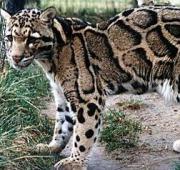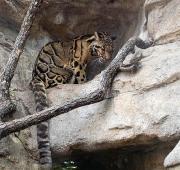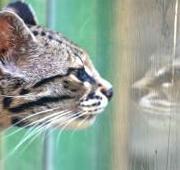 The clouded leopard is a medium-sized feline native to the thick, tropical jungles of south-east Asia. The clouded leopard has very distinctive markings on it's fur that look more like large patches compared to the spots of the African leopard. The markings of the clouded leopard are said to look like clouds, hence it's name.
The clouded leopard is a medium-sized feline native to the thick, tropical jungles of south-east Asia. The clouded leopard has very distinctive markings on it's fur that look more like large patches compared to the spots of the African leopard. The markings of the clouded leopard are said to look like clouds, hence it's name. The clouded leopard has many distinctive features along with it's beautiful markings. The clouded leopard is known to have the longest canine teeth of all the smaller sized felines and the teeth of the clouded leopard are the same length as the teeth of the tiger at around 2 inches long.
The clouded leopard has many distinctive features along with it's beautiful markings. The clouded leopard is known to have the longest canine teeth of all the smaller sized felines and the teeth of the clouded leopard are the same length as the teeth of the tiger at around 2 inches long.


There are two main species of clouded leopard, one that is found inhabiting the forests of China, Myanmar (Burma) and Nepal (it was also once found in Taiwan but is now extinct there). The other species of clouded leopard known as the Bornean clouded leopard, is found on the islands of Borneo and Sumatra along with a few smaller islands in the Indonesian archipelago.
As with other species of large, wild cat, the clouded leopard is a carnivorous animal, surviving on a purely meat based diet. Clouded leopards hunt monkeys, birds, goats, cattle, buffalo, pigs and deer in the jungle and often venture in the cultivated farmland areas if food in the jungle is scarce.
Due to the speed and size of the clouded leopard, the clouded leopard has very few natural predators in it's environment. The main predators of the clouded leopard are the tiger and the leopard, to which the clouded leopard is not closely related (despite it's name). Humans are the main predators of the clouded leopard as they hunt them fur their fur and also destroy the forest habitat in which the clouded leopard lives.
Clouded leopards are very reclusive animals and are therefore rarely seen by adventures in the wild. The clouded leopard will remain out of sight to prevent itself from being seen and hunted. Clouded leopards are very solitary animals and only come together to mate.
After a gestation period of roughly 3 months, the female clouded leopard gives birth to between 3 and 5 clouded leopard babies, known as cubs or kittens. When the clouded leopard cubs are first born they are blind and one color as their spots are joined together. The clouded leopard cubs can usually see within the first 2 weeks and develop their spots when they are older. The clouded leopard cubs are able to move around and start hunting with the mother clouded leopard when they are about 6 weeks old and usually become independent when they are 10 months of age.
Today, the clouded leopard is a species that is said to be vulnerable to extinction, due to hunting but more likely severe habitat loss. The forests in which the clouded leopard lives are being destroyed for both logging and also to make way for palm oil plantations. The clouded population numbers are severely declining and clouded leopards have been completely wiped out in some places and are therefore extinct in these regions.

